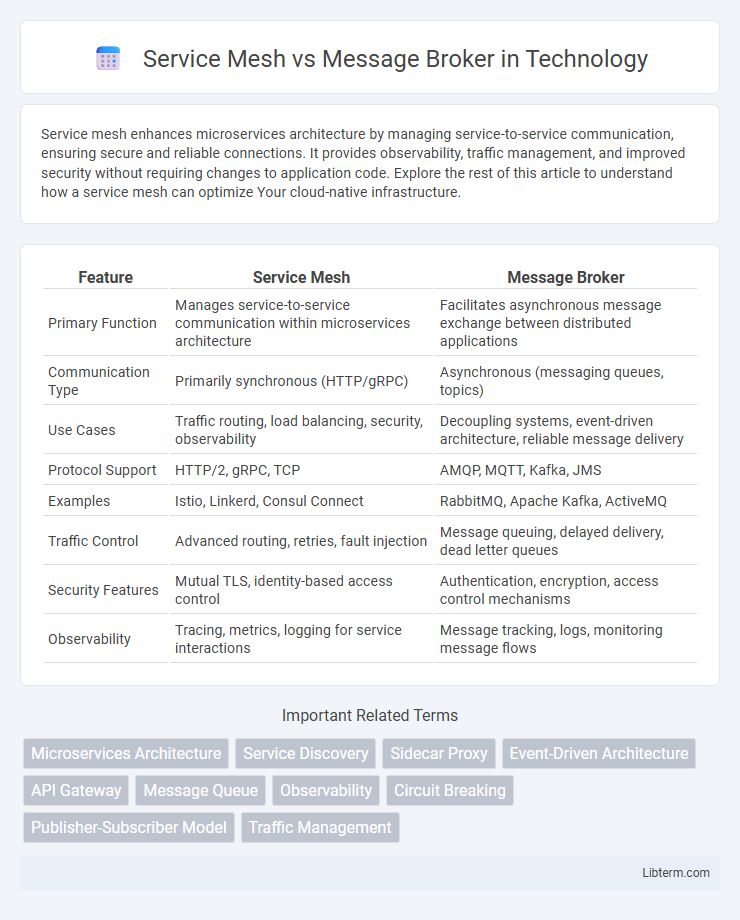Service mesh enhances microservices architecture by managing service-to-service communication, ensuring secure and reliable connections. It provides observability, traffic management, and improved security without requiring changes to application code. Explore the rest of this article to understand how a service mesh can optimize Your cloud-native infrastructure.
Table of Comparison
| Feature | Service Mesh | Message Broker |
|---|---|---|
| Primary Function | Manages service-to-service communication within microservices architecture | Facilitates asynchronous message exchange between distributed applications |
| Communication Type | Primarily synchronous (HTTP/gRPC) | Asynchronous (messaging queues, topics) |
| Use Cases | Traffic routing, load balancing, security, observability | Decoupling systems, event-driven architecture, reliable message delivery |
| Protocol Support | HTTP/2, gRPC, TCP | AMQP, MQTT, Kafka, JMS |
| Examples | Istio, Linkerd, Consul Connect | RabbitMQ, Apache Kafka, ActiveMQ |
| Traffic Control | Advanced routing, retries, fault injection | Message queuing, delayed delivery, dead letter queues |
| Security Features | Mutual TLS, identity-based access control | Authentication, encryption, access control mechanisms |
| Observability | Tracing, metrics, logging for service interactions | Message tracking, logs, monitoring message flows |
Introduction to Service Mesh and Message Broker
Service Mesh is an infrastructure layer designed to manage and secure service-to-service communication within microservices architectures, providing features like traffic control, load balancing, and observability. Message Broker facilitates asynchronous communication between distributed systems by routing, transforming, and delivering messages to improve decoupling and reliability. Both Service Mesh and Message Broker enhance scalability and resilience but operate at different communication paradigms: real-time service orchestration versus message queuing and event-driven messaging.
Core Functions of Service Mesh
Service Mesh primarily manages service-to-service communication within microservices architectures by providing traffic control, security, observability, and resilience without modifying application code. It handles load balancing, authentication, authorization, and fault tolerance at the application layer, ensuring reliable service discovery and encrypted communication between services. Unlike Message Brokers that facilitate asynchronous messaging and event-driven communication, Service Mesh focuses on synchronous API calls and network-level policies to optimize inter-service interactions.
Core Functions of Message Broker
Message brokers primarily facilitate communication between distributed applications by routing, transforming, and storing messages to ensure reliable data exchange. Core functions include message queuing, which decouples sender and receiver timing; message transformation to adapt formats; and guaranteed delivery through persistent storage and retries. Unlike service meshes that manage service-to-service connectivity and observability at the network layer, message brokers focus on asynchronous event-driven messaging patterns critical for scalable and resilient system integration.
Architectural Differences
Service Mesh primarily manages service-to-service communication within microservices architectures by providing features like load balancing, traffic routing, and security at the network layer, often implemented as a sidecar proxy alongside each service. In contrast, a Message Broker functions as an intermediary for asynchronous message exchange, decoupling producers and consumers while offering message queuing, routing, and persistence to ensure reliable inter-service communication. Architecturally, Service Mesh operates within the service runtime environment to enhance real-time service interactions, whereas Message Brokers serve as standalone middleware that manages durable message storage and delivery across distributed systems.
Communication Patterns: Synchronous vs Asynchronous
Service Mesh primarily facilitates synchronous communication patterns by managing real-time, request-response interactions between microservices, ensuring secure and reliable data exchange. Message Brokers enable asynchronous communication by decoupling sender and receiver through message queues, supporting event-driven architectures and improving scalability. Choosing between Service Mesh and Message Broker depends on the required communication latency, reliability, and system complexity.
Scalability and Performance Considerations
Service Mesh architectures enhance scalability by enabling fine-grained traffic management, secure service-to-service communication, and observability within microservices environments, which optimizes performance through load balancing and fault tolerance. Message Brokers, such as Apache Kafka or RabbitMQ, focus on decoupling services with asynchronous messaging, providing high throughput and reliable message delivery that can scale horizontally to handle large volumes of data. Scalability in Service Meshes depends on the control plane and proxy sidecars' overhead, while Message Brokers achieve performance through partitioned, distributed storage and efficient message replication strategies.
Security Features Comparison
Service meshes like Istio and Linkerd provide robust security features including mutual TLS for encrypted service-to-service communication, fine-grained access control policies, and integrated identity management to ensure strong authentication and authorization within microservices architectures. In contrast, message brokers such as Apache Kafka and RabbitMQ emphasize security through features like SSL/TLS encryption for message transport, SASL-based authentication, and role-based access control to secure data flow between producers and consumers. While service meshes offer comprehensive in-service security and observability, message brokers focus on securing data-in-motion and access at the messaging layer, making each suitable for different aspects of distributed system security.
Use Cases: When to Use Service Mesh
Service Mesh excels in microservices architectures requiring secure, reliable, and observable service-to-service communication, managing tasks like load balancing, traffic control, and service discovery within Kubernetes environments. It is ideal for use cases involving real-time service observability, policy enforcement, and mutual TLS authentication to ensure seamless inter-service communication. Unlike message brokers that focus on asynchronous message queuing and event-driven processing, Service Mesh targets synchronous, low-latency, and secure API calls between distributed services.
Use Cases: When to Use Message Broker
Message brokers are ideal for decoupling microservices in event-driven architectures, where asynchronous communication and reliable message delivery are crucial. They excel in use cases requiring message queuing, load leveling, and guaranteed delivery, such as order processing systems, financial transactions, and IoT data ingestion. Service meshes, in contrast, are better suited for managing service-to-service communication, observability, and security within synchronous API calls.
Choosing the Right Solution for Your Architecture
Service Mesh provides fine-grained control over service-to-service communication, ideal for microservices architectures requiring secure, observable, and resilient networking. Message Brokers excel in asynchronous communication, decoupling producers and consumers to efficiently handle event-driven workflows and ensure message durability. Selecting between Service Mesh and Message Broker depends on factors like communication patterns, latency sensitivity, and the need for message persistence in your system design.
Service Mesh Infographic

 libterm.com
libterm.com